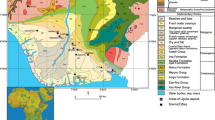Summary
Major alluvial plains contain large tracts of fine-grained muddy sediments, deposited away from the main river channels, which are mostly classed as overbank or floodplain deposits. Systematic study of the Ganga plain shows that such large tracts of deposition of muddy sediments are located several metres above the major channels, and are not flooded by overtopping of the major river channels. These surfaces are here designated as upland interfluve areas (Doab) where deposition of fine-grained sediments takes place independent of the processes operating in the main channels. The surfaces show distinct depositional domains with characteristic deposits. These include higher sloping surfaces (mottled silt), lower flat surfaces (variegated clayey silt), gulleys (sandy silt), small channels (mottled silty sand), ponds (shelly sandy clayey silt), lakes (shelly clayey silt). These deposits are prone to diagenetic changes, especially the development of calcrete horizons. Redistribution of these domains through time produces characteristic mud-dominant alluvial stratigraphy as observed in the Late Quaternary deposits of the Ganga plain. This succession shows similarity to mud-dominant deposits of the Siwalik succession. These Doab deposits are distinct from the overbank deposits formed close to the river channels affected by channel processes. It is argued that many of the thick mud-dominant fluvial deposits of the ancient fluvial record are products of deposition in upland interfluve areas.
Similar content being viewed by others
References
Agarwal, A.K., Rizvi, M.H., Singh, I.B., Kumar, A. &Chandra, S. (1992): Carbonate deposits in Ganga Plain.—In:Singh, I.B., (1992, ed.): Gangetic Plain: Terra Incognita.—35–44, Lucknow (Geology Department, Lucknow University)
Bentham, P.A., Talling, P.J. & Burbank, D.W. (1993): Braided stream and flood plain deposition in rapidly aggrading basin: the Escanilia formation, Spanish Pyrenees.—In:Best, J.L. & Bristow, C.S. (eds.): Braided Rivers.—Geol. Soc. London Spec. Publ.,75, 177–194, London
Burbank, D.W. &Beck, R.A. (1991): Models of aggradation versus progradation in the Himalayan Foreland.—Geol. Rundschau.,80, 623–638, Berlin
Farrell, K.M. (1987): Sedimentology and facies architecture of overbank deposits of the Mississippi River, False River region, Louisiana.—In:Ethridge, F.G., Flores, R.M. & Harvey, M.D. (eds.): Recent Development in Fluvial Sedimentology.—Soc. Econ. Palaeont. Min., Special Publication,39, 111–120, Tulsa
Johnson, G.D. (1977): Palaeonpedology ofRamapithecus bearing sediments, North India.—Geol. Rundschau,66, 192–216, Berlin
Johnson, M.N., Stix, J., Tauxe, L., Cerveny, P.F. &Tahirkheli, R.A.K. (1985): Palaeomagnetic chronology, fluvial processes and tectonic implications of the Siwalik deposits near Chinji Village, Pakistan.—J. Geol.,93, 27–40, Boulder
Kumar, S., Singh, I.B., Singh, M. &Singh, D.S. (1995): Depositional pattern in upland surface of Central Ganga Plain near Lucknow.—J. Geol. Soc. India,46, 545–555, Bangalore
Kumar, S., Singh, M., Chandel, R.S., & Singh, I.B. (1992): Geomorphic evolution of Lucknow area using remote sensing data analysis.—Proceeding National Symposium on Remote Sensing for Sustainable Development, R.S.A.C.-up, 269–272, Lucknow
Kumar, R. &Tandon, S.K. (1985): Sedimentology of Plio-Pleistocene late orogenic deposits associated with intraplate subduction-The Upper Siwalik Subgroup of a part of Punjab Sub-Himalaya.—Sed. Geol.,42, 105–158, Amsterdam
Miall, A.D. (1996). The Geology of Fluvial Deposits.—582 pp., Berlin (Springer)
Mukerji, A.B. (1963): Alluvial morphology of Upper Ganga Yamuna Doab.—The Deccan Geographer,2, 1–36, Hyderabad
Pathak, B.D. (1982): Ground water resources of Uttar Pradesh, India.—In:Singhal, B.B.S. (ed.): Engineering Geoscience.— 111–131, New Delhi (Sarita Prakashan)
Ray, P. (1976): Structure and sedimentological history of the overbank deposits of a Mississippi River point bar.—J. Sed. Petrol.,46, 788–801, Tulsa
Singh, I.B. (1972): On the bedding in the natural-levee and the point bar deposits of the Gomti River, Uttar Pradesh, India. —Sed. Geol.,7, 309–317, Amsterdam
— (1987): Sedimentological history of Quaternary deposit of Gangetic Plain.—Indian J. Earth Sci.,14, 272–282, Calcutta
— (1992): Geological evolution of Gangetic Plain: Present status.—In:Singh, I.B. (1992, ed.). Gangetic Plain: Terra Incognita.—1–14, Lucknow (Geology Department, Lucknow University)
— (1996a): Late Quaternary sedimentation of Ganga Plain foreland basin. Proc. Symp. N.W. Himalaya and Foredeep.— Geol. Surv. India Special Publication,21, 161–172, Lucknow
— (1996b): Geological evolution of Ganga Plain-An overview. —J. Palaeontological Society of India,41, 99–137, Lucknow
Singh, I.B. & Ghosh, D.K. (1992): Interpretation of Late Quaternary geomorphic and tectonic features of Gangetic Plain using remote sensing techniques.—Proceeding National Symposium on Remote Sensing for Sustainable Development, R.S.A.C.-U.P., pp. 273–278, Lucknow
—— (1994): Geomorphology and tectonic features of Indo-Gangetic Plain. In: Dikshit, K.R., Kale, V.S. & Kaul, M.N. (1994, eds.): India: Geomorphological Diversity.—270–286, New Delhi (Rawat Publications)
Singh, I.B., Rajagopalan, G., Agarwal, K.K., Srivastava, P., Sharma, M. &Sharma, S. (1997): Evidence of Middle to Late Holocene neotectonic activity in the Ganga Plain.— Current Science,73, 1114–1117, Bangalore
Sinha, R. (1995): Sedimentology of Quaternary alluvial deposits of the Gandak-Kosi interfan, North Bihar plains.—J. Geol. Soc. India,46, 521–532, Bangalore.
Smith, N.D. &Perez-Arlucea, M. (1994): Fine-grained splay deposition in the avulsion belt of the lower Saskatchewan River, Canada.—J. Sed. Res.,64, 159–168, Tulsa
Tanaka, S. (1994): Palaeosols in the Churia (Siwalik) Group, West Central Nepal.—In:Kumar, R., Ghosh, S.K. &Phadatare, N.R. (eds.): Siwalik Foreland Basin of India.—181–204, New Delhi (Oxford and IBH Publishing Co. Pvt. Ltd.)
Tye, R.S. &Coleman, J.M. (1989a): Depositional processes and stratigraphy of fluvially dominated lacustrine deltas: Mississippi Delta Plain.—J. Sed. Petrol.,59, 973–996, Tulsa
—— (1989b): Evolution of Atchafalaya lacustrine deltas, South-Central Louisiana.—Sed. Geol.,65, 95–112, Tulsa
Willis, B. (1993): Ancient river systems in the Himalayan foredeep, Chinji village area, Northern Pakistan.—Sed. Geol.,88, 1–76, Amsterdam
Willis, B.J. &Behrensmeyer, A.K. (1994): Architecture of Miocene overbank deposits in Northern Pakistan.—J. Sed. Res.,64, 60–67, Tulsa
Author information
Authors and Affiliations
Rights and permissions
About this article
Cite this article
Singh, I.B., Srivastava, P., Sharma, S. et al. Upland interfluve (Doab) deposition: Alternative model to muddy overbank deposits. Facies 40, 197–210 (1999). https://doi.org/10.1007/BF02537474
Received:
Revised:
Issue Date:
DOI: https://doi.org/10.1007/BF02537474




